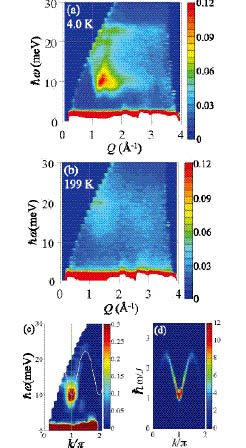Neutron Scattering Study on Alternating Spin-3/2 Chain Compound YCrGeO5
M. Hase, T. Masuda, and K. Kindo
Neutron scattering technique is known as a powerful tool to probe the spin correlation in magnetic materials. Among various types of neutron instruments the chopper spectrometer is designed particularly for collecting inelastic neutron scattering (INS) spectrum. Combination of position sensitive detectors and accumulative data-acquiring system leads to a state-of-art instrument for measuring the dynamical structure factor S(q,ω). Neutron Scattering Laboratory operates the High Resolution Chopper (HRC) spectrometer installed in J-PARC/MLF. The instrument covers the incident neutron energy range 10 meV ≤ Ei ≤ 500 meV and the scattering angle range 0.3º ≤ ψ ≤ 40º, which meets typical magnetic scattering in most of magnetic materials. In this highlight we introduce a recent study on an alternating spin-3/2 chain compound by using the HRC spectrometer.

Fig. 1. (a) Inelastic neutron scattering (INS) spectrum of YCrGeO5 at 4.0 K. (b) INS spectrum of YCrGeO5 at 199 K. (c) INS spectrum converted to one-dimensional dynamical structure factor. (d) Calculated dynamical structure factor by DMRG method.
The phase diagrams of the alternating spin chain systems for various magnitudes of spin were extensively studied theoretically [1-4]. The model Hamiltonian is ![]() . In case of spin-3/2 chain the spin alternation δ induces a spin gap at 0 < δ < 0.42(2) and 0.42(2) < δ ≤ 1, and the ground state is non-magnetic singlet. Tomonaga-Luttinger liquid (TTL) state exists at δ = 0 and 0.42(2). So far no experimental study has been reported because of absence of the model compound. Recently we found that RCrGeO5 is a rare experimental realization of the spin-3/2 alternating spin chain. In this study we performed inelastic neutron scattering experiments on the polycrystalline sample of YCrGeO5 to observe the magnetic excitation and to identify the spin Hamiltonian.
. In case of spin-3/2 chain the spin alternation δ induces a spin gap at 0 < δ < 0.42(2) and 0.42(2) < δ ≤ 1, and the ground state is non-magnetic singlet. Tomonaga-Luttinger liquid (TTL) state exists at δ = 0 and 0.42(2). So far no experimental study has been reported because of absence of the model compound. Recently we found that RCrGeO5 is a rare experimental realization of the spin-3/2 alternating spin chain. In this study we performed inelastic neutron scattering experiments on the polycrystalline sample of YCrGeO5 to observe the magnetic excitation and to identify the spin Hamiltonian.
INS spectrums are shown in Figs. (a) and (b). The excitations are observed in the energy range of 8 meV ≤ ℏω ≤ 23 meV at 4.0 K and the intensity decreases with the increase of Q. The intensity is suppressed at higher temperature of 199 K. The results mean that the observed excitations are dominated by magnetic scattering. No excitation is observed at ℏω ≤ 8 meV and this reveals the existence of the spin gap. The obtained powder INS spectrum was converted to the one-dimensional S(q,ω) [5] as shown in Fig. (c). The obtained profile was reproduced by empirical dispersion formula ℏω = √A2(sin k)2 + Δ2 with the parameters Δ = 10 meV and A = 20 meV. Figure (d) shows the dynamical structure factor calculated by DMRG with δ = 0.75 and Δ/J=1.1 and the calculation is consistent with the experiment. The measured magnitude of the spin gap is Δ = 10 meV and this leads to J = 11meV. By using these parameters the magnetic susceptibility was quantitatively reproduced. Thus our study revealed that YCrGeO5 is the first experimental realization of the spin-3/2 alternating spin chain.
As shown in Figs. (a) and (b) INS spectrum with high experimental resolution can be efficiently collected by using HRC spectrometer. Although the polycrystalline sample form, one-dimensional S(q,ω) can be obtained by the elaborated analysis. Combination of chopper spectrometer and polycrystalline sample will be a defacto standard in forthcoming era of neutron science.
References
- [1] Y. Kato and A. Tanaka, J. Phys. Soc. Jpn. 63, 1277 (1994).
- [2] M. Kohno, M. Takahashi, and M. Hagiwara, Phys. Rev. B 57, 1046 (1998).
- [3] M. Yajima and M. Takahashi, J. Phys. Soc. Jpn. 65, 39 (1996).
- [4] S. Yamamoto, Phys. Rev. B 55, 3603 (1997).
- [5] K. Tomiyasu, M. Fujita, A. I. Kolesnikov, R. I. Bewley, M. J. Bull, and S. M. Bennington, Appl. Phys. Lett. 94, 092502 (2009).
